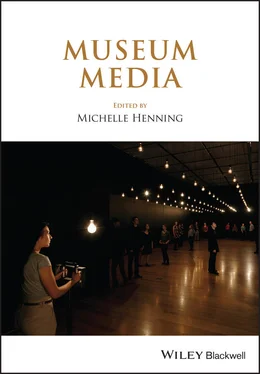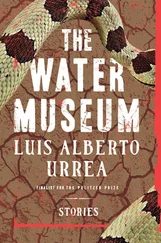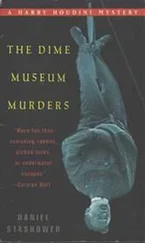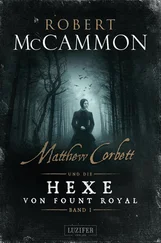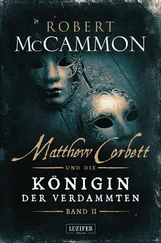If they are exhibited, video testimonies occupy a rather peculiar position among the things shown in an exhibition. For museum exhibitions, Roger Fayet proposes a distinction between primary, secondary, and tertiary museum objects (2007, 24). Primary museum objects are the things and artworks that are exhibited. Secondary museum objects are the “models, replicas, reconstructions or visual representations as well as textual information” (Fayet 2007, 26) that are used to explain to the visitors how they should read the primary museum objects and what they are supposed to represent. Tertiary museum objects are objects that are in the museum, that do not directly have relevance for the exhibition, but that nevertheless influence the way in which the exhibition is received by the visitors – such as CCTV cameras, signs for emergency exits, or fire extinguishers. Video testimonies are generally used as a combination of the three: they stand for themselves as self-explanatory museum objects; they serve as secondary museum objects for other objects; and the choice of device on which they are shown and their aesthetics have some bearing on the reception of the exhibition by the visitors. Using selected examples, in what follows I will reflect on those three functions of video testimonies in more depth.
So far few museums have decided to base their exhibitions exclusively on video testimonies. An exception is the Museo Diffuso, which has already been mentioned above. In the Museo Diffuso, there is only one museum text – a time line of the war that is barely readable – and two objects – an execution chair and a printing press used by partisan groups. The main exhibition objects are video testimonies and videos with archival footage. In this museum, the video testimonies are exhibited as primary museum objects and carry the exhibition narrative.
In most museums however, video testimonies are shown in conjunction with material objects, documents, and pictures. They are placed in relation to the latter and used to comment on them. For the objects in what he calls “memorial museums,” Paul Williams has observed that, “in a sense, it is the story that is the object, insofar as it is not the item itself that is distinctive, but the associated history to which it is attached” (2007, 133).
This accounts for most objects in museums of contemporary history. Video testimonies are a particularly pertinent means to reveal this story. Thus, the Jewish Museum in London, for example, has based its exhibition chapter on the Holocaust almost exclusively on the story of Leon Greenman, a survivor of six concentration camps whose wife and son died in Auschwitz. In the middle of the exhibition, a glass case shows some personal belongings of Greenman and his family such as his son’s toy truck, his wife’s wedding dress, and his camp uniform. In the film, Greenman talks about these objects. As I have shown elsewhere with reference to examples in Yad Vashem and in the Bergen-Belsen Memorial, the objects and the video testimonies are here placed in a relationship of mutual authentication (De Jong 2011b; 2012; 2013).
As observed above, witnesses to history have been accepted as legitimate carriers of cultural memory. This legitimation is based on the perceived authenticity of their testimonies. Witnesses to history have physically been at the events on which they give testimony. Their presence in time and place authenticates their testimonies given subsequently. In the case of video testimonies with Holocaust survivors such as Leon Greenman, the “authentic” character of the testimonies is reinforced by the extraordinary brutality of their experiences. “While treacherous happiness is easily suspected to be a masquerade, in pain, man appears as an untainted being that is not bound to any rules of orchestration,” observes Helmut Lethen (1996, 221). The suffering of Holocaust survivors is supposed to have left uncontrollable traces on their psyche – it is supposed to have traumatized them. The most pertinent extra-verbal expressions of testimony referred to above – such as tears, lapsing into silence, and uncontrollable twitches – are interpreted as an expression of this trauma (De Jong 2013, 23). The juxtaposition of objects and video testimonies in which witnesses to history speak about those objects duplicates the “authentic” character both of the witnesses to history and of the objects. The material reality of the objects and the represented authenticity of the video testimonies meld. We believe Greenman’s story because we see the historical objects, while the testimony authenticates the objects as originals.
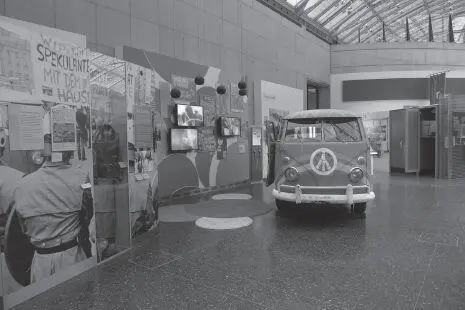
FIGURE 4.3View of exhibition section on the beat generation in the Haus der Geschichte.
© Steffi de Jong.
Generally, however, the link between video testimonies and objects is less direct – but no less effective for that. In the Haus der Geschichte in Bonn, visitors are presented with video testimonies on topics like the end of World War II, flight and displacement, the June 17, 1953 uprising in East Germany, or the construction of the Berlin Wall, and also, for example, the foundation of the Green Party or the beat generation. The most prominent object in the exhibition section on the beat generation is a pink VW bus with a rainbow ceiling. On the wall, videos show popular bands of the time, fashion shows, important political events such as the Vietnam War, influential figures like Martin Luther King, Jr., and Che Guevara, as well as student demonstrations (see Figure 4.3). Through different sensory means, the visitor is affectively drawn into the time of the flower-power generation.
A combination of original objects, film footage, and video testimonies is often supposed to create an “authentic” experience for visitors. They are invited to become witnesses to history themselves. Thus, Dorit Harel, who designed the new exhibition in Yad Vashem, writes of one of the many reconstructions in the museum that “authentic cobblestones of Leszno Street in the Warsaw Ghetto, surrounded by its sights and sounds, authentic artefacts, enlarged film-montage from the period, blow-up photographs, and other multidisciplinary means ... generate an experience that is close to authentic” (2010, 42).
Such an “authentic” experience, while it might be intended, can never be complete. Visitors are hardly ever made to forget that they are in a museum. Being temporally distant from the events, they never completely fit in. Video testimonies can reinforce this dual character of the visitors’ experience. While they link the objects to lived stories, thus facilitating immersion in the period, they also remind the visitors that the time that is represented – whether good or bad – is over. They are often used to offer an interpretation of this time in hindsight. All but one of the witnesses to history in the Haus der Geschichte have cut their long hair and discarded their hippy clothes. The testimonies focus on the political impact of the beat generation, especially in East Germany. For example, East and West German participants of the Youth Meeting in East Berlin in 1963 remember how the youth movements influenced East and West German politics to the point that the Beatles could be played on East German youth radio and the government started to actively target the youth. Many of the witnesses to history romanticize the time when they were young rebels, with long hair and miniskirts, living in communes. Some, however, criticize the relationship between consumption and the beat generation. Thus, Günter Zint, a photographer, observes that everything from longhaired wigs to Indian necklaces was marketed and that the beat generation’s incorporation into the capitalist system in fact killed their ideals. Zint unmasks the myth of an alternative lifestyle that surrounds the hippies, of which objects like the VW bus and the bands are symbols. Visitors are, here, turned partly into participants and partly into observers. The VW bus, the music and pictures from the time, and the video testimonies invite the visitors to immerse themselves in the past. At the same time, the video testimonies also serve as critical “museum text” to the other exhibits.
Читать дальше
